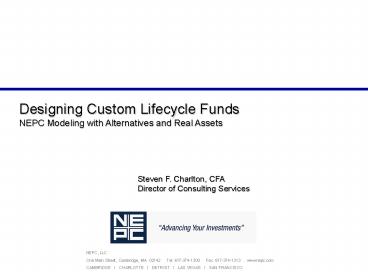LASERS Asset Allocation Follow Up - PowerPoint PPT Presentation
1 / 7
Title:
LASERS Asset Allocation Follow Up
Description:
Designing Custom Lifecycle Funds. NEPC Modeling with Alternatives and Real Assets ... NEPC views the incorporation of equity alternatives as a more efficient ... – PowerPoint PPT presentation
Number of Views:55
Avg rating:3.0/5.0
Title: LASERS Asset Allocation Follow Up
1
Designing Custom Lifecycle Funds NEPC Modeling
with Alternatives and Real Assets
Steven F. Charlton, CFA Director of Consulting
Services
NEPC, LLC One Main Street, Cambridge, MA 02142
Tel 617-374-1300 Fax 617-374-1313
www.nepc.com CAMBRIDGE I CHARLOTTE I
DETROIT I LAS VEGAS I SAN FRANCISCO
2
Alternatives Equity Alternatives
Equity Alternatives In recognition of longer
life expectancies, most lifecycle managers have
increased the equity content of far-dated funds
to 80 or more of assets. NEPC views the
incorporation of equity alternatives as a more
efficient use of capital. Our recommendation is
to reduce equity content and seek equity
alternatives for the pre-age 65 portfolio, and
solve for longer life expectancy by amassing a
greater wealth portfolio at age 65, and then
managing that effectively. Our asset allocation
to Equity Alternatives is constrained by the
number of daily valued products available.
Equity alternatives lower portfolio volatility
- Equity alternatives include
- Global asset allocation strategies
- Private equity
- Unconstrained equity
without dampening portfolio returns
This illustration compares the impact to
portfolio return and risk by adding 10
increments of equity alternative assets to an
equity portfolio. Equity is represented by
NEPCs Capital Market assumptions for the SP 500
Index. These are forward-looking assumptions.
Volatility is defined as the annualized standard
deviation.
3
Alternatives Bond Alternatives (i.e. Real
Return Assets)
Real Return Assets Lifecycle funds need equity
diversifiers, but core bonds are our third best
idea. Real Asset strategies (TIPS, Commodities,
Real Estate and Timber) and Absolute Return
strategies are our first and second best ideas.
Inflation is the bane of DC investors, who are
trying to grow their savings (and expected
retirement spending) at a rate that exceeds the
natural inflation of those goods services. Real
assets are investments in things, non-financial
stores of value that increase portfolio
diversification and hedge against inflation.
Absolute return strategies may use portable alpha
long/short strategies on top of a cash or TIPS
benchmark, or tactically allocate among a basket
of real and financial assets. Our asset
allocation to Real Return is constrained by the
number of daily valued products available.
Real return assets are a free lunch, lowering
portfolio volatility
and increasing portfolio returns
This illustration compares the impact to
portfolio return and risk by adding 10
increments of real return assets to a core bond
portfolio. Core bonds are represented by NEPCs
Capital Market assumptions using the Lehman
Aggregate Index. These are forward-looking
assumptions. Volatility is defined as the
annualized standard deviation.
4
Glide Path Comparisons
NEPC favors the Glide Path with Equity and Bond
(Real Return Asset) Alternatives, over the
equity-centric Glide Path without Alternatives
5
Hypothetical Glide-path
6
NEPC Hypothetical Modeling Results
Expected income replacement rates for each glide
path were calculated by multiplying expected
retirement savings (Portfolio Wealth at age 65)
by the spending rate (5) and then dividing by
the final salary.
7
Why Alternatives and Real Asset Strategies?
- Lowers overall portfolio volatility while
maintaining or even increasing expected portfolio
returns relative to less diversified mixes - Increases probability of achieving target
retirement income replacement ratios - Forecasts higher risk-adjusted returns than the
traditional core asset classes - Can react faster and more easily to changing
asset class valuations - Potential for tactical allocations to
non-traditional asset classes - Potential for alpha from multiple decisions
- A domestic large cap equity manager is limited by
the market they invest in and index to which they
are benchmarked - Helps protect participants against the risks of
inflation































